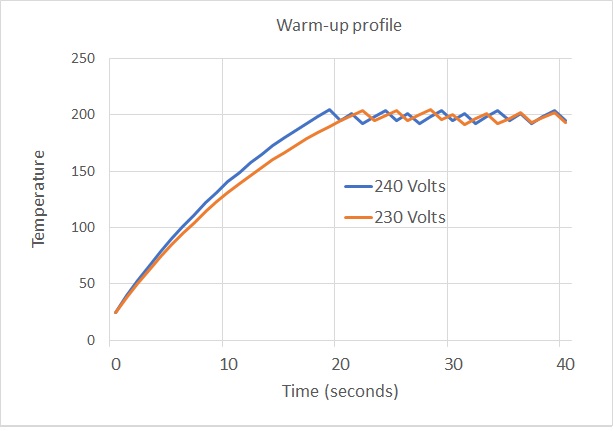Although it is perfectly true that reducing the supply voltage to an electric heater will reduce its power consumption, this is not the same as saying its energy consumption will decrease. In fact, if it is thermostatically controlled, it will merely run for longer to maintain the energy input needed to balance the thermal energy requirement of the process or space being heated. If the heat output is regulated, energy consumption will not reduce with lower voltage.
But for some heating processes the effect of reduced voltage is actually perverse. For example, consider a laser printer. One of the components in the printer, the fuser unit, contains a heated roller maintained at around 200°C whose job is to melt the toner particles on the paper surface. The heater in the roller is likely to be rated at 500 watts or more, and to minimise energy consumption it is turned off when the printer goes into standby. That is why it can take 20 seconds or so to wake the printer up: the heater element has to boost the roller back up to temperature.
Suppose the element has a resistance of 100 Ω at its normal operating temperature. At 240 V, the current flowing will be 2.4 A (by Ohm’s law) so its power will be 240 x 2.4 = 576 W. Reduce the voltage to 230 V and the current drops to 2.3 A, yielding 529 W, a power reduction of just over 8%.
However, reduced power output means it takes a little longer to reach operating temperature. In the simple simulation illustrated below, the warm-up time increases from 19 to 22 seconds.

Unfortunately, 22 seconds at 529 watts is 11.6 kJ, whereas 19 seconds at 576 watts (the higher-voltage scenario) is only 10.9 kJ. So the warm-up cycle uses more electricity at lower voltage. Sadly this additional startup energy consumption is not counteracted by savings elsewhere, since all the other electronic components of the printer will be fed from stabilised power supplies and therefore do not respond to fluctuations in mains voltage.
OK, the energy waste penalty of operating at reduced voltage is absolutely tiny – I quite accept that – but the point is that it is not a saving, let alone a saving of 8%. Furthermore there are plenty of cyclical heating processes from kettles to school pottery kilns where minimising warm-up time will save more than downrating the heater output.